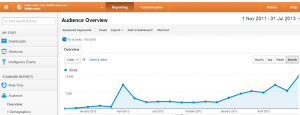After installing e17 on Gentoo and a few applications, I noticed that some of the applications in the menu had icons while others did not. The same icons were missing in the IBar and other places. At first, I checked the wiki page on e17, it suggested to install evas_generic_loaders with SVG support. Contrary to what it suggests, evas_generic_loaders does not affect menu icon display it is used for tooltip previews in the file browser.
The way to set is to navigate to Settings -> All -> Look -> Application Theme and open the Icons tab. Once I selected Gnome, all the icons appeared. “Enable icon theme for applications” was already checked by default. If you do not see Gnome icons in the Icons tab, make sure you have installed x11-themes/gnome-icon-theme if you’re using Gentoo.
Fiddle Salad has accumulated many features, but where are they? In keeping with one of its principles, features are hidden until the situation calls for them. One example is the JavaScript errors that are shown on hover over the results window. Recently, I’ve decided showing an unobtrusive tips window is as good as hiding features to reduce UI clutter. So, let’s start with 4 lines of Knockout code.
TipsPanel = ->
@startup = ko.observable(not store.get('hideTipsOnStartup'))
@startup.subscribe((checked) ->
store.set('hideTipsOnStartup', not checked)
)
I start by setting startup to a storage value using store.js. It uses HTML5 local storage with cookies for fallback. Since I want to show the tips panel by default and hideTipsOnStartup would not be set, startup is set to the opposite hideTipsOnStartup. JavaScript’s ! and CoffeeScript’s not casts an expression to a boolean, as required by Knockout’s checked binding.
Next, I add a manual subscription to the observable so that its value is stored each time the checkbox is checked or unchecked.
Finally, the checkbox is bound to tips.startup where tips is a TipsPanel instance.
<label><input data-bind="checked: $root.tips.startup" type="checkbox"/> Show tips on startup
</label>
The idea of running Fiddle Salad came in a weird way. At first, I was just making a Python to JavaScript compiler and putting it on a website. It was simple enough, as the compiler was already built for it. The back-end for saving and authentication through Google, Twitter, and Facebook used the same one as Python Fiddle. After the site was launched, I noticed that not many people were interested in writing Python. Also, I got a taste of CoffeeScript, which is now my favorite language.
I think the demise of the Python-only fiddle came as a combination of low traffic and no saves. If nobody ever sees it or uses it, then it is better gone. Fortunately, I had the chance to design and develop the next generation of Fiddle Salad to support other languages.

The real Fiddle Salad was launched in April of 2012. I remembered calling the previous version Python Fiddle. Last January, I decided to do an experiment with the CoffeeScript page by creating a separate app in the Chrome App Store. It turned out to double my number of daily visitors. Last May, it was featured on Lifehacker as one of the best apps for development. So why not do it again?
I waited until the right time. Last month and the previous one, the project received major updates which I will be discussing on the Fiddle Salad blog. Meanwhile, I published more apps in the Chrome App Store.
The difference now is that instead of an app supporting more features that show up in searches, I’ve limited the features that are marketed. This way it targets specific audiences. JavaScript programmers don’t want to find out about the features built for CoffeeScript, and a programmer looking for a CoffeeScript IDE won’t bother with an app that doesn’t have CoffeeScript in the title.
